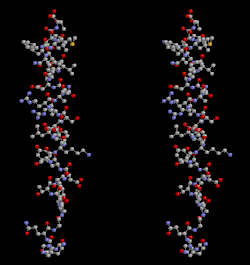 | |
| Clinical data | |
|---|---|
| Trade names | Glucagen, Baqsimi, Gvoke, others |
| AHFS/Drugs.com | Monograph |
| MedlinePlus | a682480 |
| License data | |
| Pregnancy category |
|
| Routes of administration | Intranasal, intravenous (IV), intramuscular (IM), subcutaneous |
| ATC code | |
| Legal status | |
| Legal status | |
| Identifiers | |
| |
| CAS Number | |
| PubChem CID | |
| IUPHAR/BPS | |
| DrugBank | |
| ChemSpider | |
| UNII | |
| KEGG | |
| ChEBI | |
| ChEMBL | |
| Chemical and physical data | |
| Formula | C153H225N43O49S |
| Molar mass | 3482.80 g·mol−1 |
| 3D model (JSmol) | |
| |
| |
| | |
Glucagon, sold under the brand name Baqsimi among others, is a medication and hormone. [9] As a medication it is used to treat low blood sugar, beta blocker overdose, calcium channel blocker overdose, and those with anaphylaxis who do not improve with epinephrine. [10] It is given by injection into a vein, muscle, or under the skin. [10] A version given in the nose is also available. [11]
Contents
- Medical uses
- Low blood sugar
- Beta blocker overdose
- Anaphylaxis
- Impacted food bolus
- Endoscopic retrograde cholangiopancreatography
- Adverse effects
- Contraindications
- Mechanism of action
- History
- References
- External links
Common side effects include vomiting. [10] Other side effects include low blood potassium and low blood pressure. [9] It is not recommended in people who have a pheochromocytoma or insulinoma. [10] Use in pregnancy has not been found to be harmful to the baby. [12] Glucagon is in the glycogenolytic family of medications. [10] It works by causing the liver to break down glycogen into glucose. [10]
Glucagon was approved for medical use in the United States in 1960. [10] It is on the World Health Organization's List of Essential Medicines. [13] It is a manufactured form of the glucagon hormone. [10] A generic version became available in the United States in December 2020. [14]



